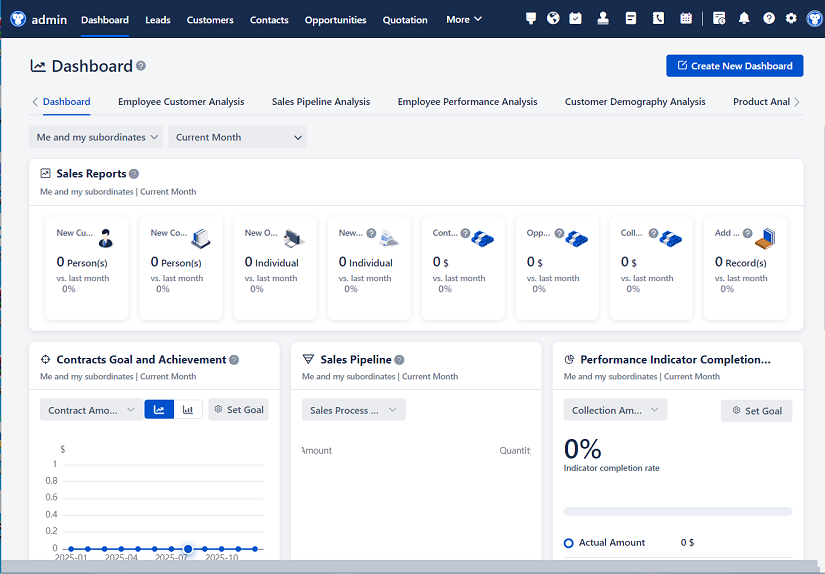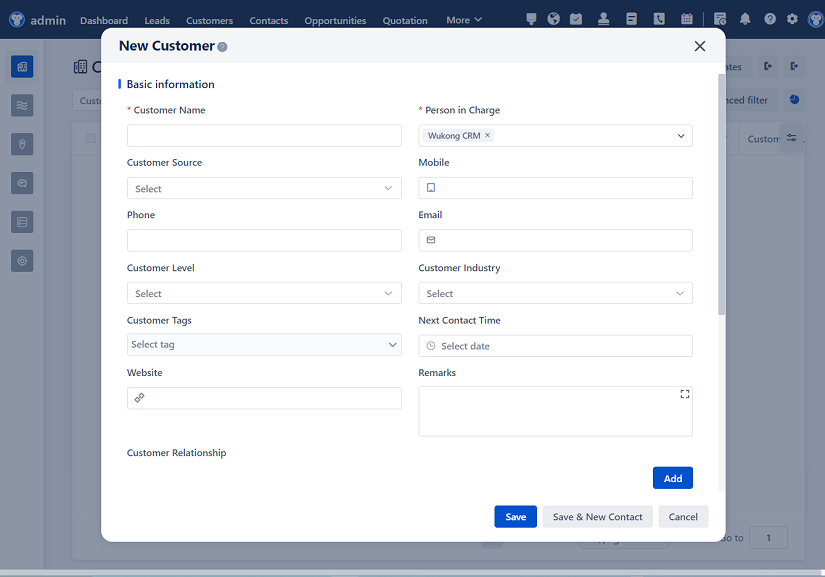
△Click on the top right corner to try Wukong CRM for free
Hey there! So, you're looking to get the most out of your CRM (Customer Relationship Management) system for marketing and promotion, huh? Well, you've come to the right place. Let me walk you through it in a way that's easy to understand and, hopefully, a bit fun too.
First things first, let's talk about what a CRM system is. It's like this big digital Rolodex, but way cooler. You can store all sorts of information about your customers—like their names, contact details, and even what they like or dislike. It's super helpful for keeping track of who's who and what's what.
Now, why would you want to use a CRM for marketing and promotion? Well, imagine having a tool that not only helps you remember your customers' birthdays but also tells you when they last bought something from you. That's pretty powerful, right? It means you can send them personalized messages at just the right time, making them feel special and more likely to buy from you again.
Alright, so how do you actually use a CRM for customer marketing and promotion? Let's dive into some practical steps.
1. Get to Know Your Customers
The first step is to really get to know your customers. I mean, really know them. What are their interests? What do they like to buy? When do they usually make purchases? The more data you have, the better. And don't worry, most CRMs make it easy to collect and organize this information. Just make sure you're doing it in a way that respects their privacy and follows all the rules and regulations.
2. Segment Your Audience
Once you have all this data, it's time to segment your audience. Think of it like sorting your socks. You wouldn't put all your socks in one drawer, right? You'd separate them by color, size, and maybe even by which ones you wear on special occasions. The same goes for your customers. Group them based on common characteristics, like age, location, or buying habits. This way, you can tailor your marketing messages to each group, making them more relevant and effective.
3. Personalize Your Messages
Now, here's where the magic happens. With all this data and segmentation, you can start sending personalized messages. Imagine if you got an email that said, "Hey [Your Name], we noticed you love our chocolate chip cookies. How about trying our new double-chocolate chunk flavor?" Wouldn't that make you feel special? Personalization is key to building strong relationships with your customers. It shows that you care and that you're paying attention to their preferences.
4. Automate Your Campaigns
Automation is your best friend when it comes to CRM. It's like having a personal assistant who never sleeps. You can set up automated campaigns to send emails, text messages, or even social media posts at specific times or based on certain triggers. For example, you could set up an automated email to go out to customers who haven't made a purchase in a while, offering them a special discount. Or, you could send a birthday message with a coupon. The possibilities are endless, and the best part is, once you set it up, it runs on its own.
5. Track and Analyze Your Results
Okay, so you've got your campaigns running, and you're sending out all these personalized messages. But how do you know if it's working? That's where tracking and analysis come in. Most CRMs have built-in tools to help you see how your campaigns are performing. You can track open rates, click-through rates, and even sales. This data is gold because it tells you what's working and what's not. Use it to tweak your campaigns and make them even better.
6. Follow Up and Follow Through
Finally, don't forget to follow up and follow through. If a customer responds to one of your messages, make sure you reply promptly. If they make a purchase, thank them and ask for feedback. If they have a problem, solve it quickly. The goal is to build long-term relationships, and that means being there for your customers every step of the way.
So, there you have it! Using a CRM for customer marketing and promotion doesn't have to be complicated. It's all about getting to know your customers, segmenting your audience, personalizing your messages, automating your campaigns, tracking your results, and following up. With a little effort and the right tools, you can create a marketing strategy that not only brings in more sales but also builds lasting relationships with your customers.
Q: Can I use a CRM for both B2B and B2C marketing? A: Absolutely! CRMs are versatile and can be used for both B2B and B2C marketing. The key is to tailor your approach based on the type of customers you're dealing with. For B2B, you might focus more on account-based marketing and long-term relationships, while for B2C, you might focus on more frequent, personalized promotions.

Q: How often should I send marketing messages to my customers? A: It depends on your audience and the type of messages you're sending. Generally, it's a good idea to find a balance. Too many messages can be annoying, but too few might make you forgettable. Start with a frequency that feels right, and then use the data from your CRM to adjust as needed. Pay attention to open and click-through rates to see what works best.
Q: Is it possible to integrate my CRM with other tools, like email marketing software? A: Yes, definitely! Many CRMs offer integrations with popular email marketing tools, social media platforms, and even e-commerce systems. This makes it easier to manage all your marketing efforts from one place. Check with your CRM provider to see what integrations are available and how to set them up.
Q: How can I ensure that my CRM data is accurate and up-to-date? A: Keeping your CRM data accurate and up-to-date is crucial. Make sure to regularly clean and update your data. Encourage your customers to provide updated information, and use tools within your CRM to identify and remove duplicates or outdated entries. Regularly reviewing and maintaining your data will help you get the most out of your CRM.

Q: What if I'm just starting out and don't have a lot of customer data yet? A: No worries! Everyone starts somewhere. Even if you don't have a lot of data, you can still use a CRM to start collecting and organizing the information you do have. As you grow, you'll naturally gather more data. The important thing is to start using the CRM early so you can build a solid foundation for your marketing and promotional efforts.
I hope this helps, and good luck with your CRM journey!
Related links:
Free trial of CRM
Understand CRM system
AI CRM Systems

△Click on the top right corner to try Wukong CRM for free